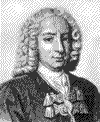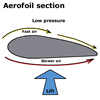![]() In this module you will see how various forces combine to get an
aircraft into the air, to maintain flight and to be able to maneuver.
The basic principle used is that of aerodynamics: - the science of air
moving around objects, and the effects this movement has on the air and
the object. Since the Wright Brothers' first flight in a powered heavier-than-air
machine in 1903, the same principles of aerodynamics have been applied
to every aeroplane ever flown.
In this module you will see how various forces combine to get an
aircraft into the air, to maintain flight and to be able to maneuver.
The basic principle used is that of aerodynamics: - the science of air
moving around objects, and the effects this movement has on the air and
the object. Since the Wright Brothers' first flight in a powered heavier-than-air
machine in 1903, the same principles of aerodynamics have been applied
to every aeroplane ever flown.
The four forces
 When
an aeroplane is flying, there are four forces in operation - lift, gravitational
force, thrust and drag. For an aeroplane maintaining constant altitude,
and a constant speed, the forces of lift and gravitation, are equal to
those of thrust and drag.
When
an aeroplane is flying, there are four forces in operation - lift, gravitational
force, thrust and drag. For an aeroplane maintaining constant altitude,
and a constant speed, the forces of lift and gravitation, are equal to
those of thrust and drag.
Unbalancing forces of lift and gravitational force causes the plane to climb or descend, and the other pair of forces, thrust and drag, controls horizontal acceleration and thus air speed.
Each force will now be considered separately.
Lifting forceThe gravitational force
The gravitational force is the force that acts between any two bodies
with mass. It pulls every object on the surface of the Earth or near the
Earth towards the centre of the Earth - that's why an aircraft remains
on the ground until a lifting force is applied, and why a continuous upward
force is needed to balance the downward gravitational force. For a plane
to climb a greater lifting force than gravitational force is needed, then,
when the aircraft is at a steady cruising altitude, only enough force
to equal the downward force of gravity is needed. These two forces of
lift and gravity control up and down movements - but what about speed?
You are about to find out.
Thrust and drag
If you have ever travelled in a large passenger plane you will have experienced
the scream of the engines as they drive the aircraft forward. They are
creating the force called thrust that will drive the wings through the
air, so that the Bernoulli effect can operate. At the same time there
is air resistance and skin friction where air passing over the body of
the plane tries to drag it back. Modern aircraft are streamlined to reduce
drag, and more efficient jet engines can create even more thrust.

|
Forces on an aircraft |
| Copyright owned by the State of Victoria (Department of Education and Early Childhood Development). Used with Permission. |
 An
aircraft wing is made in a particular cross-section called an aerofoil.
As air passes around the aerofoil the air on top of the aerofoil
travels further than the air below. This means that the air on top
of the wing travels faster than the air passing under the wing.
This is because the wing moving through the air determines the time
taken for the air to move over or under the wing surface and both
must be the same.
An
aircraft wing is made in a particular cross-section called an aerofoil.
As air passes around the aerofoil the air on top of the aerofoil
travels further than the air below. This means that the air on top
of the wing travels faster than the air passing under the wing.
This is because the wing moving through the air determines the time
taken for the air to move over or under the wing surface and both
must be the same. 